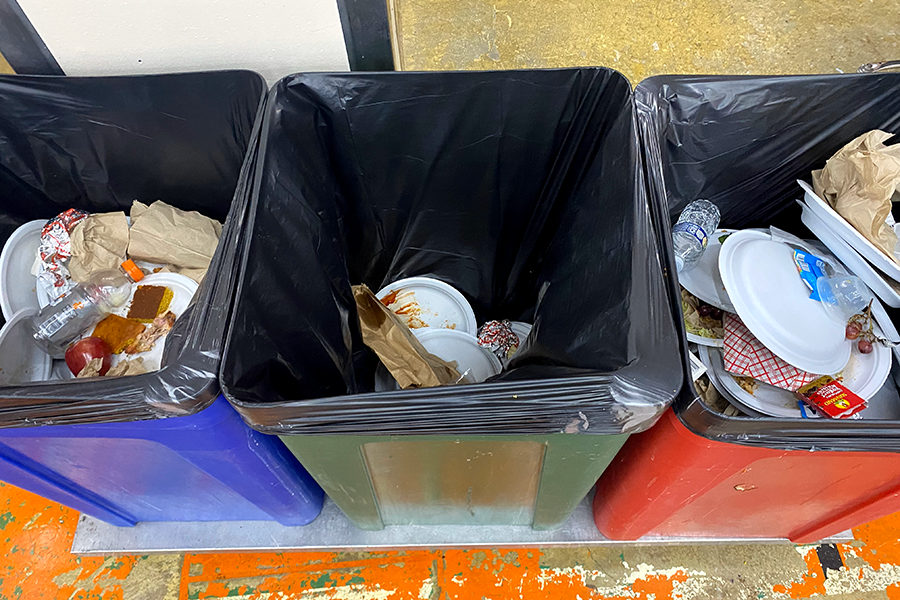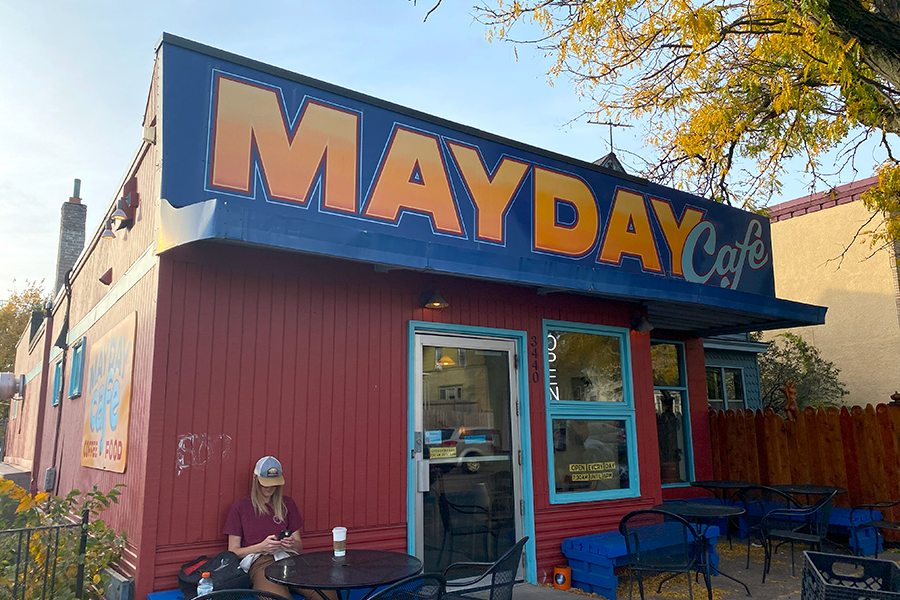Despite the winter cold, four brave souls venture out into the windy yard at junior Wilson Cross’ house. Braveheart, courageous as her name, is the first out, followed by Clucky, Bravething, and Thing 2. These morning risers are chickens, belonging to Cross and his family. They are part of a growing movement in the Twin Cities to bring growing food to their back yard.
Cross owns four chickens, two Bard Rocks, and two Rhode Island Reds, each with distinctive personalities. “[Braveheart is] always the first to come out of the coop,” Cross described. Braveheart, one of the Bard Rocks, contrasts with Clucky.
“She is the most cowardly, and she clucks a lot. Our Bard Rocks, we could not tell them apart for the longest time, so we called them Thing 1 and Thing 2. But then it became apparent that one of them was much braver than the other, so that one became Brave Thing, after Braveheart.”
Madison Richter, a junior, owned chickens for a year and half in a coop attached to his garage.
“My Mom had a friend who owned chickens, and it interested her because they were able to take care of chickens pretty well in their neighborhood,” Richter stated.
Cross’s parents were also the impetus for getting chickens.
“They [my parents] decided they would like to try having chickens,” Cross said, “we started looking into plans for building chicken coops, and such.”
At Egg/Plant, an urban farm supply store in St. Paul, coops can cost between $500-600. However, many beginning chicken farmers choose to cut costs by employing their own handicraft skills and materials that they had leftover from other projects.
“We assembled the chicken coop out of mostly leftovers,” said Cross. Cross estimated that, by creating a homemade coop, he reduced the price to $200, a $300 difference from a store bought enclosure.
On top of the one-time expenses, chickens take continual investments in food, hay, and bedding. The cost of all of these items varies wildly between farmers, based on where they buy their supplies, and how much of it they choose to make at home.
Richter estimated that, for feed, personal labor, hay, and other things that his chickens required, they paid around $150 every month. Cross, facing the same costs, used the opportunity to both cut down on the money spent, and the kitchen waste that his household produced.
“Chicken scraps, that would go out to the compost, we toss into the chicken enclosure,” Cross said.
On top of these expenses, potential chicken raisers must go through a process to obtain a permit.
“I know that animal permits are getting more strict, so once our chicken permit expires, we’re going to have to do some more work to get that [coop] up to code,” Cross said.
According to the Minneapolis Minnesota Chicken Ordinance, permits are necessary for anybody hoping to keep small fowl. This includes getting at least 80% of the neighbors within 100 feet of the potential chicken’s dwelling to give their permission, as well as paying a $50 application fee.
After obtaining the permit, Cross and his family set up their coop. They encountered problems as soon as its roof was raised.
“The first day we had them, a hawk swooped on our chickens, so we had to put up a bird net right away,” Cross remembered. Luckily, no chickens were harmed in this incident.
Audrey Matson, the owner of Egg/Plant supply store, agreed that predators are a major problem faced by chicken keepers in the city.
“A lot of things want to eat chickens,” Matson stated, naming raccoons and foxes as two of the most eager carnivores. To lessen the risk of snatched chickens, she recommended securely locking them up at night.
Smell was another factor that led to complications in Cross’s chicken scheme.
“They used to be closer to to our house, and that was kind of smelly, because they’re pooping all over, so we moved them farther back. That was an adventure!” Cross laughed. “It’s, like, a 500 pound chicken coop, we had to roll it on rollers, but that worked out pretty well. No real problems, just changes in the plan.”
To Richter and his family, it seemed like their plan, and the chickens’ plans had different objectives.
“My mom thought it would be good for keeping the yard clean, in a sense, and keeping stuff from getting dirty, and leaves piling up, but it was kind of the opposite effect than we thought,” Richter said. “We did get a lot of eggs, which was nice, but they ended up eating a lot of the flowers, and destroying most of my mom’s garden.”
Because of the mess that chickens make, many chicken raisers find the upkeep the birds require is quite intensive.
“You have to make sure your yard is pretty clean, because they like to go to the bathroom a lot,” stated Richter. “And their coop needs to be cleaned very often, or else it gets moldy, and sometimes mice come in there too.”
The only monetary compensation that chicken farmers get is from the eggs, which, if they have enough birds, they can sell. However, Cross only gets enough eggs for his family to eat. In the summer, they can get up to four eggs, one per chicken. Cross has found that benefits of homegrown eggs extend beyond the money they get back.
“We hope to improve our own health by eating better eggs. I mean, they’re better. They’re better for you. They have more nutrients in them, they look yellower, I mean, it’s an aspect of the diet we feed them,” Cross said. “It’s what they would eat if they were wild birds, so, it just makes them better.”
The quality of home produced eggs has not gone unnoticed by the general population.
“There’s a lot of interest,” Matson, of Egg/Plant, stated. “Last year we sold over 600 chicks, and we expect there to be more this year.”
Egg/Plant has responded to the growing attention and action around chicken raising in Minneapolis. They have developed chicken-keeping classes for potential owners. Last year, Egg/Plant also hosted a “Chicken People Party,” a gathering for, as Matson so aptly put, “chicken people.”
On Google groups, there is a group with, according to Matson, 500-600 members, called “Twin Cities Chickens,” where chicken owners can ask questions, get answers, and discuss their fowl in a friendly manner.
“I think people like to produce their own food at home. It makes them feel closer to their food,” Matson explained.
For those who are not able to grow their own chickens, but still support the movement localizing the production of food, several options are available.
“Have gardens, and whatnot is the best you can do, the next best thing. Like community gardens, or just your own personal garden probably,” Richter recommended. “A lot of people I know have gardens of their own, and there’s the Dowling community gardens that are really big, and a lot of people use them.”
Self production is one way people contribute to growing food in a healthier way.
“You can buy into coops that are out of the city, get produce, and meat products from there,” stated Cross. “And there are also some, not local, but in Minnesota farming operations, that are greener. Not necessarily organic, but free range.”
Now that Cross has the chicken field covered, he and his family are keeping their eyes on the future. And, whether that future may take the shape of a goat.
“My parents have talked about it [getting a goat],” Cross said, “but we’d have to get food for it too, and it’s not really feasible quite yet!”








